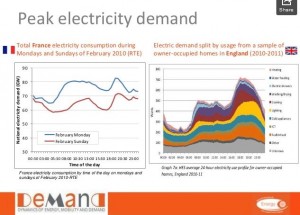 Presentation given at Behave Energy Conference, Oxford, 3-4 September 2014.
Presentation given at Behave Energy Conference, Oxford, 3-4 September 2014.
Abstract: Energy consumption is often analysed as the outcome of people’s individual choices involving the use of technical devices. But it can also be seen as resource that underpins the energy consuming practices that people perform. The explicit study of practices, defined as clusters of activities, held together by meaning, material embodiment and coherent performance, and shared by a number of carriers across time a space, could improve our ability to model how the related energy consumption builds up and evolves. Practice theory has been successfully applied in the qualitative analysis of in-depth interviews and historical material including in the energy consumption field. However, the application of this theory to more structured and quantitative data remains limited. The aim of this paper is to demonstrate how this theory can apply to the analysis of the flow of activities reported through the activity diaries forming national Time Use Surveys. This application would enable the use of these large scale representative population datasets for the modelling of the co-evolution of practices, technologies and infrastructures and consequent domestic energy consumption.
In this perspective, we first define practices as entities we can clearly identify and search for in the physical and social space described in the Time Use data. In this study, we concentrate on several practices (including cooking & eating). These were first defined as an activity or a cluster of activities (sequence or co-occurrence) in relation to a specific objective. They were then refined based on their fundamental attributes: duration, number of participants and place of occurrence. The paper will describe how these practice ‘definitions’ were achieved and will then compare their distributions in terms of temporality and socio-demographic profiles. The paper will then also analyse the constraints and opportunities for them to develop and spread and the consequential implications for the potential modification of the temporal cycles of energy demand.
As the paper will show, in spite of many limitations, this rare attempt at a direct use of the theory of practice for the analysis of quantitative data provides some new insights on the benefits and difficulties coming along this approach. This study both extends the field of empirical data to which the theory of practice can be applied, renew the methods for the analysis of people daily activities, and sheds new light on the dynamics underlying energy consumption diversity and evolution.

